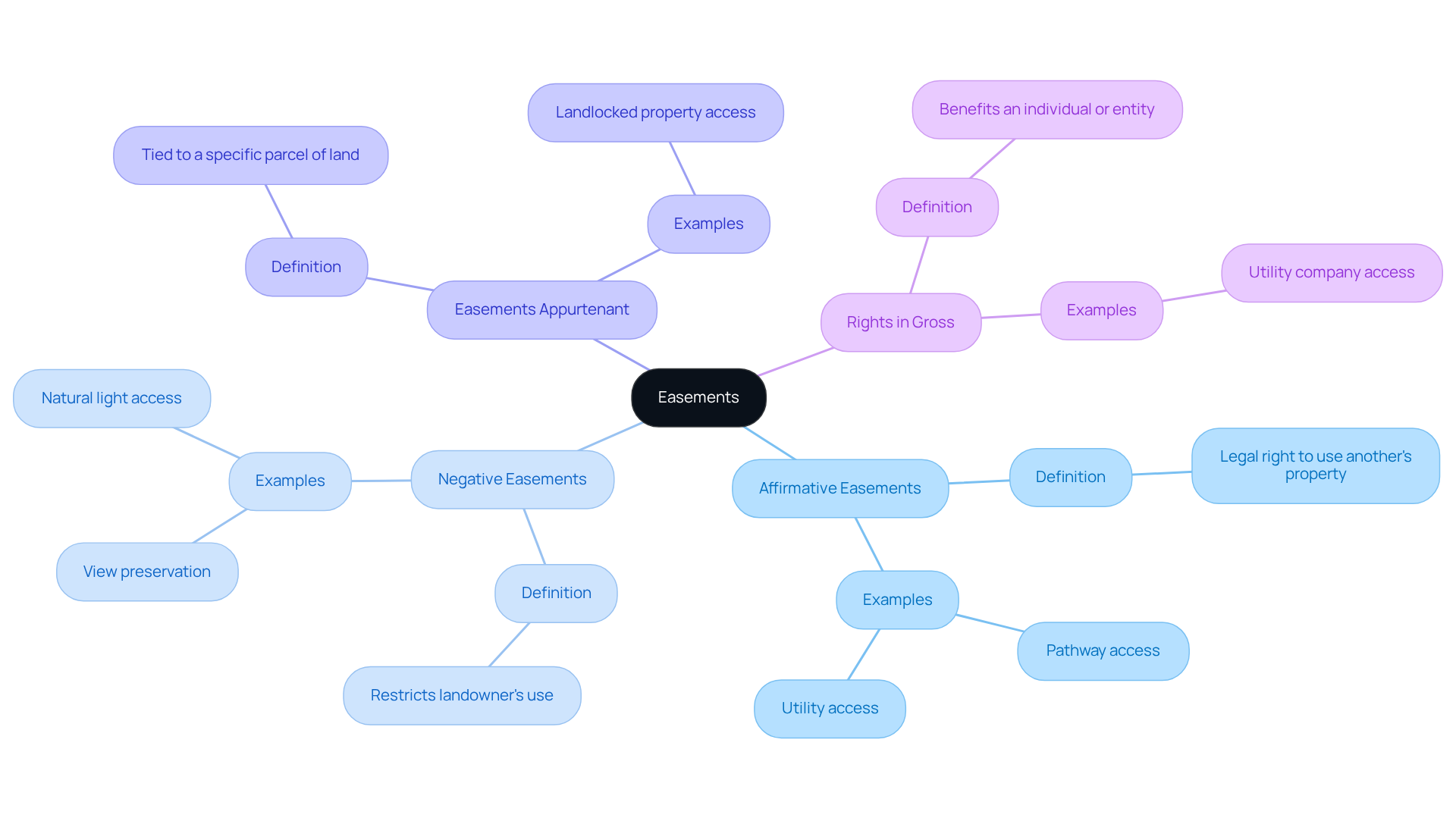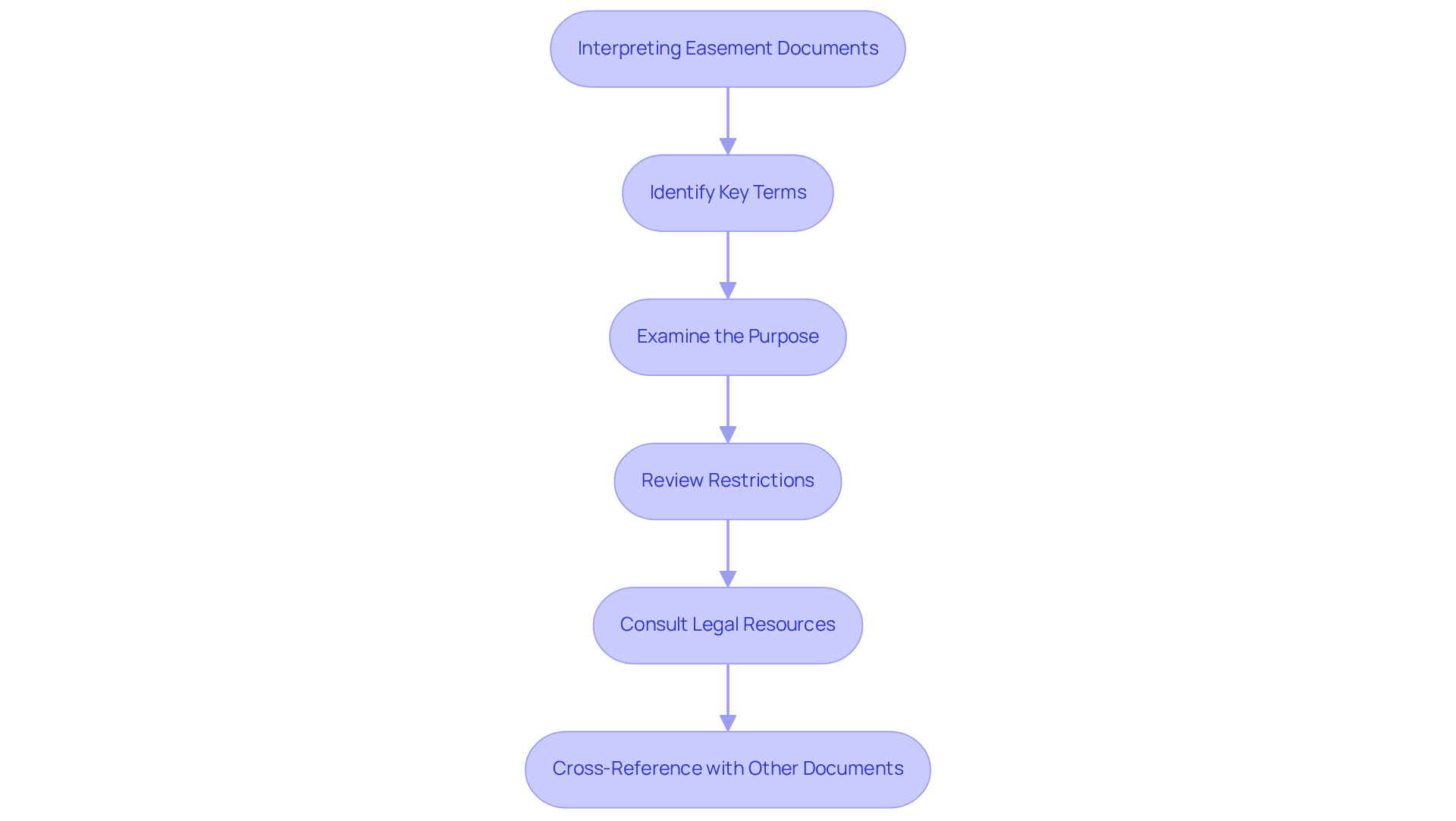Overview
Investigating easements on a property requires a systematic approach. Begin by reviewing the title document, as this is crucial for understanding property rights. Furthermore, check county records and utilize online databases to gather comprehensive information. Obtaining title reports and consulting survey maps are essential steps that cannot be overlooked. Understanding the types of easements and their legal implications is vital, as these factors significantly influence property ownership rights, land use, and overall property value. By following these steps, property owners can navigate the complexities of easements effectively.
Introduction
Understanding the complexities of property rights is an essential task for any landowner or prospective buyer. Easements, which grant specific usage rights over another's land, play a pivotal role in determining ownership and land use. Therefore, it is crucial to investigate them thoroughly.
This article guides readers through the key steps of title research, revealing how to:
- Locate easements
- Interpret legal documents
- Assess their potential impact on property value
As the landscape of property rights evolves, it becomes increasingly important to ensure that one is fully informed and protected against unforeseen limitations.
Define Easements and Their Types
Easements represent legal rights that help explain how to investigate easements on a property, permitting one party to utilize another party's land for a specific purpose. Understanding how to investigate easements on a property is essential for assessing their impact on ownership rights and land use. The primary categories include:
- Affirmative Easements: These rights enable the holder to undertake specific actions on the servient estate, such as traversing the property or accessing utilities. For instance, a homeowner may possess a positive right to utilize a pathway across a neighbor's land. The prevalence of affirmative rights of way underscores their significance in real estate law.
- Negative Easements: In contrast, these easements restrict the landowner from engaging in activities that would normally be permissible, such as obstructing a view or interfering with natural light. A common example is a negative right preventing a landowner from constructing a building that obstructs a neighbor's picturesque view.
- Easements Appurtenant: These easements are tied to a specific parcel of land (the dominant estate) and confer benefits to that parcel, transferring with ownership. For example, if a parcel is landlocked, a right of way may grant access to a public road. The existence of such rights of way can significantly influence property valuation.
- Rights in Gross: Distinct from appurtenant rights, these rights benefit an individual or entity rather than a specific piece of land. Utility companies frequently hold rights of way to install and maintain infrastructure, such as power lines or water pipelines.
Recognizing these categories of rights of way is vital for understanding how to investigate easements on a property and their potential effects on ownership rights, usage, and overall asset valuation. Moreover, employing clear and consistent language in property agreements is critical to preventing future disputes. Easements can be established through express grant, implied grant, and prescription—factors of considerable importance for landowners and prospective purchasers.

Locate Easements in Property Records
To locate easements in property records, follow these steps:
- Begin with the Title Document: The title document frequently holds essential details regarding any rights of way linked to the land. Search for specific terminology that clearly refers to rights of way.
- Check County Recorder's Office: Visit or contact your local county recorder's office to access public records. These offices preserve crucial records associated with land ownership, including information on how to investigate easements on a property, which are vital for understanding land limitations.
- Utilize Online Real Estate Databases: Many counties now provide online databases where you can search for records by address or owner name. These databases often contain documents related to property rights, simplifying the recognition of any restrictions.
- Review Title Reports: Obtain a title report from a title company if available. This report generally contains any documented rights of way impacting the property, offering a thorough summary of possible restrictions.
- Consult Survey Maps: Survey maps can also show rights of way and are accessible through local planning departments or professional surveyors. These maps provide detailed arrangements of land parcels and can assist in clarifying boundary measurements and access points.
By following these steps on how to investigate easements on a property, you can effectively identify rights of way that may influence the property in question, ensuring compliance with regulations and preventing costly disputes. Significantly, as of 2020, 81,896 km of U.S. land was safeguarded by perpetual conservation agreements, emphasizing the importance of comprehending these legal rights. As President Biden mentioned, there is an objective to protect 30% of U.S. lands by 2030, making the recognition of land rights increasingly pertinent. Furthermore, it's crucial to recognize that there are five categories of access deeds specified by state law, which can additionally impact land use.

Interpret Easement Documents and Legal Language
Interpreting property rights documents demands meticulous attention to detail. Here are essential tips to enhance your understanding:
- Identify Key Terms: Concentrate on critical terms such as 'grant', 'right-of-way', 'burdened property', and 'dominant estate'. A firm grasp of these terms is vital for understanding the scope and implications of the right of way.
- Examine the Purpose: Clarify the specific aim of the right of way. Whether it is for utility access, pedestrian passage, or another function, comprehending its intent will illuminate how it influences land use.
- Review Restrictions: Scrutinize any limitations outlined in the document. These may include restrictions on construction, maintenance duties, or specific usage rights that could impact development.
- Consult Legal Resources: When confronted with particularly complex language, seek guidance from legal resources or professionals specializing in real estate law. Their expertise can provide clarity and avert misinterpretations.
- Cross-Reference with Other Documents: Compare the access document with other property records to ensure consistency and to contextualize it within the broader framework of property rights.
Mastering these interpretation skills is crucial, as misunderstandings can lead to disputes. Statistics indicate that legal conflicts regarding property access interpretations are prevalent, with maximum dispute costs reaching $400,000. Real estate attorneys emphasize that a comprehensive understanding of legal terminology in property rights is essential for safeguarding clients' interests and preventing costly lawsuits. By honing these abilities, you can navigate the intricacies of rights of way and their effects on land ownership more effectively. Furthermore, be aware that the duration for prescriptive rights varies by state, with Massachusetts requiring 20 years and Rhode Island 10 years—essential information for title researchers.

Assess the Impact of Easements on Property Value
Easements can significantly influence property value, and understanding this impact requires careful consideration of several factors.
-
Type of Right of Way: The character of the right of way plays a crucial role in its impact on real estate value. Utility rights of way generally have a lesser impact compared to right-of-way agreements, which can impose significant restrictions on access and usage, such as limiting the ability to build fences or plant trees in the area.
-
Location and Visibility: The positioning of a right-of-way within the land can greatly influence its worth. Easements situated in notable locations or those that are very visible may reduce the overall attractiveness and market worth.
-
Market Perception: Buyer sentiment regarding land rights is vital. If a right of way is viewed as a constraint, it can discourage prospective purchasers, thus diminishing the asset's marketability and worth. Some purchasers may even decline real estate with current restrictions, necessitating vendors to locate interested buyers.
-
Legal Restrictions: It is essential to review any legal constraints related to the right of way. These restrictions can dictate how the asset can be utilized or developed, further influencing its overall valuation. Furthermore, rights of way can reduce real estate value by a specific sum, which can be utilized for compensation discussions.
-
Consult with Appraisers: Engaging with real estate appraisers is advisable for a thorough evaluation. Their expertise can offer valuable insights into how rights of way are incorporated into land valuations, ensuring a comprehensive understanding of the asset's worth. Property owners may also receive compensation for a right of way linked to fair market value, which is an important consideration.
By considering these elements, property owners and prospective buyers can better understand how to investigate easements on a property and how they may affect property value, leading to more informed decision-making in real estate transactions.

Conclusion
Understanding how to investigate easements on a property is crucial for anyone involved in real estate—be it an owner, buyer, or investor. This guide outlines the essential steps and considerations necessary to navigate the complexities of easements effectively, emphasizing their legal implications and potential impact on property value.
Key points discussed include:
- The definition and types of easements
- The process of locating them in property records
- The importance of accurately interpreting legal documents
Each easement type, from affirmative to negative, holds unique significance that can influence land use and ownership rights. The steps for locating easements—such as reviewing title documents and consulting county records—provide a practical roadmap for thorough title research. Furthermore, understanding the nuances of easement documents is vital for preventing disputes and protecting property interests.
In conclusion, a comprehensive grasp of easements is not only beneficial but necessary for informed decision-making in real estate transactions. As the landscape of property rights continues to evolve, staying informed about easements and their implications empowers individuals to make better choices regarding their properties. Engaging with real estate professionals and utilizing available resources enhances understanding and ensures compliance with legal requirements, ultimately safeguarding investments and facilitating smoother transactions.
Frequently Asked Questions
What are easements?
Easements are legal rights that allow one party to use another party's land for a specific purpose, impacting ownership rights and land use.
What are the main types of easements?
The main types of easements include Affirmative Easements, Negative Easements, Easements Appurtenant, and Rights in Gross.
What is an Affirmative Easement?
An Affirmative Easement enables the holder to undertake specific actions on the servient estate, such as traversing the property or accessing utilities.
What is a Negative Easement?
A Negative Easement restricts the landowner from engaging in activities that would normally be permissible, like obstructing a view or interfering with natural light.
What are Easements Appurtenant?
Easements Appurtenant are tied to a specific parcel of land (the dominant estate) and provide benefits to that parcel, transferring with ownership.
What are Rights in Gross?
Rights in Gross benefit an individual or entity rather than a specific piece of land, commonly held by utility companies for infrastructure purposes.
Why is it important to understand easements when investigating a property?
Understanding easements is vital for assessing their impact on ownership rights, usage, and overall asset valuation.
How can easements be established?
Easements can be established through express grant, implied grant, and prescription.




